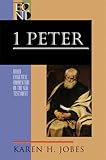
In this commentary on 1 Peter, Karen Jobes makes some important contributions to the academic study of this epistle, while at the same time providing an excellent resource for pastors and Bible students who want to wrestle with the meaning and application of the text. The introduction is comprehensive and defends traditional authorship of the letter (bolstered by a thorough appendix on the quality of the Greek which indicate an author whose first language was not Greek) and and early date (based largely on the observation that the letter does not address state-sponsored persecution). She also puts forward her thesis that the Christians to whom Peter writes had been recolonised by the Roman empire – literally exiled and living as resident aliens. She shows throughout the commentary how this makes many of Peter’s points particularly apt, but acknowledges that the main thrust of the argument does not depend on whether his readers are literal exiles or not.
The commentary itself is very thorough, and manages to deal with issues of Greek grammar and syntax without losing focus on the message of the book. Jobes seems to have a very good understanding of the types of questions that preachers will be asking of the text, and while this is not an exposition of 1 Peter, it is full of theological and pastoral observations. As with all volumes in the Baker Exegetical Commentary series, the layout is excellent, including the full text of the passage being commented on, and with regular summaries of argument. Technical notes are kept out of the way at the end of each section rather than as footnotes, and Greek is both transliterated and translated.
Peter quotes from and alludes to the Old Testament regularly in this letter, and whenever he does, Jobes highlights not just the passage quoted but similarities in the flow of argument and thought (especially with Psalm 34).
There is a substantial section devoted to dealing with the difficult passage at the end of chapter 3. She rejects the view that Christ preached through Noah to Noah’s generation, and also the descent into hell view, in favour of the modern consensus that views 1 Enoch as the background to the passage – the risen and ascended Christ has proclaimed victory over fallen angelic beings and powers. She differentiates between Paul’s use of ‘flesh’ (Greek sarx), which connotes our sinful human nature, to Peter’s which is merely referring to bodily life on earth (as opposed to the eternal spiritual state Jesus was in after his resurrection). This means that her interpretation of a number of verses does not fit well with the English translations, which use the word “body” as a translation (for example, in her view baptism in 3:25 is said not to morally transform the believer, rather than not physically wash the believer that most modern translations imply).
It is also of interest to see how a female commentator in a conservative evangelical commentary series approaches the injunctions of 3:1-6 concerning a wife’s submission to her husband. She (rightly in my view) interprets this section along with the preceding section addressed to slaves as being motivated by Peter’s concern for the vulnerable situation that wives and slaves find themselves in if they convert to Christianity. Slaves and wives found themselves right at the bottom of the social ladder of their day, and so Peter writes pastorally, and should therefore not be criticised for failing to undermine these social structures. She defends Peter against modern critics by claiming that he dignifies slaves and wives by affirming their rights to their own religious beliefs.
She notes that Peter leaves the details of how submission is to be worked out to the wives and husbands themselves (for example, would an unbelieving husband allow his wife to worship with the Christian community). She also contrasts Peter’s teaching on wives and husbands with Paul’s, which is targetted at believing couples. While she indicates a moderately complementarian leaning by affirming that the NT does envisage some form of “submission” from wives to husbands, she stresses the freedom that is given to the married couple to work this out between themselves, without specifying the exact details of how this works out in practice. The implication is that in a Christian marriage, this “submission” should have a very different dynamic to that found in other marriages of Peter’s day. She quotes approvingly an unamed evangelical who states that while the NT teaches a wife to submit, it does not ever give the husband the right to demand it.
I found this an excellent commentary to consult as I studied my way through 1 Peter recently. It provides answers not just for exegetical questions, but pointers for application, and discussion of theological implications. Her thesis concerning the recipients of the letter and her appendix assessing whether the quality of the Greek rules out Petrine authorship will probably be of more use to academics than Bible teachers, but these are kept separate from the main commentary so they do not get in the way for those not requiring such information.

Pingback: Book Review – NIVAC Esther (Karen Jobes)